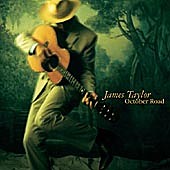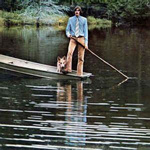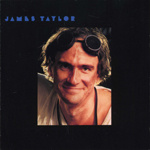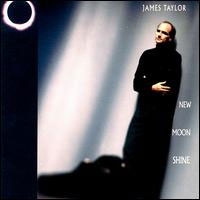Features
Gone To Carolina In My Mind
James Taylor Albums Ranked From Worst To Best
by Jason Warburg
To the casual observer, any individual James Taylor album might feel more or less interchangeable with the others—both because his style has been remarkably consistent over the years, and because the gap in quality between his worst and best albums is pretty narrow. James Taylor has never made a bad album, just a few that have felt somewhat looser, less focused or less inspired, as well as a few that focus on covers rather than his typically powerful originals. This list, then—like all the others, if we’re being realistic—is for the fans, the devotees who’ve gobbled up every bit of singer-songwriter supreme Taylor’s output dating back to his 1968 Apple Records debut.
Without rehashing the man’s entire well-known backstory, James Taylor was born into a troubled yet undeniably musical family, embraced singing and songwriting early, and fumbled about in his late teens until fortuitously falling in with, gulp, The Beatles just as they were launching Apple Records in 1968. Further tribulations, personal tragedies and addictions ensued, but by 1971 Taylor was firmly established as one of the leading lights of the singer-songwriter movement, a soft rock superstar with a gift for earnestly baring his soul without surrendering his sardonic sense of humor.
A dozen hit singles and half a dozen high-charting albums later, Taylor was a global icon whose personal life lay in shambles. A very public divorce from fellow singer-songwriter Carly Simon and a couple of underperforming albums led to a period of retrenchment in the 1980s, a decade that saw Taylor focus more on live work, building a steady following for his annual summer tours. A minor creative renaissance occurred in the ’90s, though by then Taylor’s muse had slowed its pace, if not its potency. In the latter third of his career, since his 1997 album Hourglass won a Grammy, Taylor has received numerous honors but infrequently composed new songs, delivering more covers than originals over that span.
Regardless of what anyone makes of that trajectory, Taylor will always stand tall as one of the founding fathers of the singer-songwriter genre, delivering a remarkably potent mixture of clever poetry and searing personal revelation set to music that has veered between acoustic ballads, blue-eyed soul, and engaging folk-rock. With a voice for the ages and a distinctive finger-picking style, Taylor has always been both one of a kind and an approachable everyman, shy and awkward when he’s not performing, and a man thoroughly possessed by his mistress music when he is.
17(t). James Taylor At Christmas (2006), American Standard (2020), Covers (2008)
All three of these latter-day collections of covers are pleasant enough, anchored by Taylor’s resonant, comforting tenor and easygoing sense of humor. But James Taylor is not just a singer; he’s a singer-songwriter, or maybe even a songwriter-singer, with the result that these albums end up feeling like momentarily entertaining novelties rather than anything more meaningful.
 16. Before This World (2015)
16. Before This World (2015)
Taylor’s only album of originals in the past two decades feels more like an “empty the vaults” exercise than a fresh, coherent album. A couple of clear highlights—the upbeat road song “Stretch Of The Highway” and decade-late tribute to the 2004 Red Sox “Angels Of Fenway”—are surrounded by a batch of craftsmanlike but mostly unremarkable tunes. (In an ironic intergenerational footnote, when the album went to #1, it displaced Taylor Swift—who was named for James.)
15. October Road (2002)
As I put it a few years back: “Taylor… has officially reached the pantheon of American composers and singers. He is as original as Gershwin, as recognizable as Sinatra, as compelling as Woody Guthrie. And he is quite simply the gold standard when it comes to confessional singer-songwriter folk-rock. Having said that, one also gets the sense that at this stage in his career Taylor is perhaps running a little low on inspiration… Even the frank, skillfully-woven narrative of the summing-it-all-up tune "Carry Me On My Way" suffers a bit from an arrangement that sounds suspiciously like, well, a James Taylor song.”
 14. Walking Man (1974)
14. Walking Man (1974)
For better or worse, producer-guitarist David Spinozza brought a more burnished sound to this album than on earlier, more homespun JT outings. Unfortunately, several tracks are saddled with overly busy arrangements, and the songs themselves represent one of James’ less inspired sets. There just isn’t much of note here song-wise once you get past the autobiographical title track; not even guest harmony vocals from Carly Simon and Paul and Linda McCartney on multiple tracks and a late-breaking, exuberant Chuck Berry cover (“The Promised Land”) are enough to lift this one out of the doldrums.
13. One Man Dog (1972)
An early-days album that lacks the focus of subsequent efforts; the shaggy arrangements and gang vocals on tunes like “One Man Parade” and “Who, Don’t You Know” and the mix of short songs and shorter instrumental interludes lend the album a “some friends came by with a couple of joints and a bottle of tequila” vibe that’s warm, hazy fun but ultimately leaves the album feeling tossed off. The exceptions—and easily the best things here—are the three tunes that feel finished and self-contained: the plaintive, seductive “Don’t Let Me Be Lonely Tonight,” the searching, philosophical “Someone,” and the thrummy road song “Back On The Street Again.”
 12. Never Die Young (1988)
12. Never Die Young (1988)
After issuing eight albums in the 1970s, Taylor managed just three in the ’80s, of which this, the last, was also the slightest. The melodic title track and only charting single revisits the thematic ground of “That Lonesome Road,” another cautionary tale about hard-living friends departing too soon. Keyboard player, musical director and producer Don Grolnick delivers crystal-clear sonics as Taylor gets gently funky with Little Feat’s Bill Payne (“T-Bone”), indulges in nostalgia (“Baby Boom Baby”) and romance (“Valentine’s Day”), and explores gospel-funk (“Sun On The Moon”) and playful r&b (“Sweet Potato Pie”). It’s all pleasant and professional, just not especially memorable.
11. Flag (1979)
The joyous family man of JT takes a dark turn on this somewhat muddled two-years-later follow-up, matching songs intended for an unproduced Broadway musical called Working (“Company Man,” “Brother Trucker,” “Millworker”) with a mishmash of middling originals, a cover that works (a soaring take on “Up On The Roof”) and one that doesn’t (an ill-conceived run at “Day Tripper”), and a decade-later remake of his own “Rainy Day Man.” It’s the definition of a mixed bag, led by the superb “Up On The Roof,” the frisky “Is That The Way You Look?” and the haunting “Sleep Come Free Me,” though the rest is mostly forgotten now.
 10. Dad Loves His Work (1981)
10. Dad Loves His Work (1981)
The title of this album, released as Taylor’s marriage to Carly Simon was crumbling around them, is said to have been directed at his workaholic father, but also feels like a veiled confession to his own young children. The album itself is an uneven exercise with high highs—the rousing “Stand And Fight,” the sunny “Summer’s Here,” and devastating closer “That Lonesome Road” in particular—peeking out from a less memorable pool of too-slickly-produced second-tier tunes. His duet with J.D. Souther “Her Town Too” deftly explores the social and emotional landscape of his impending divorce, but beyond those four tracks there isn’t much of note here.
9. James Taylor (1968)
The foundations of all that was to come can be found here: luminous acoustic ballads (“Something In The Way She Moves”), sweetly churning gospel-soul numbers (“Don’t Talk Now”), and autobiographical songs (“Carolina In My Mind,” “Rainy Day Man”) that sometimes leaven their serious topics with edgy humor (“Knockin’ Round The Zoo”). Unfortunately, as a first-time recording artist Taylor wasn’t yet in a position to push back on some of the more overbearing production elements—in-song orchestrations and between-song segues that subtract by addition—but the native talent and authentic voice behind the songs found here is evident.
 8. Hourglass (1997)
8. Hourglass (1997)
One of those mid-career outings that tries hard to be better than it is, Hourglass delivered enough emotional heft and truth with enough A-list guest stars (e.g. Branford Marsalis, Yo-Yo Ma, Sting, Stevie Wonder) to snare a typically way-late-and-for-the-wrong-album Grammy. It’s home to a handful of strong tunes (the topical “Line ’Em Up” and the autobiographical “Enough To Be On My Way,” “A Little More Time With You” and “Jump Up Behind Me”) and a few more solid ones, but several secondary tracks feel like retreads or filler, and this album’s tepid cover (“Walking My Baby Back Home”) should probably have been saved for Covers.
7. That’s Why I’m Here (1985)
Legend has it that the recently-divorced and still-addicted Taylor was considering quitting music when he was invited to play the inaugural Rock In Rio festival in January 1985. The warm embrace of the massive crowds he played to revived his spirit, and soon after he got sober for good and delivered this album-long affirmation of what he does and why he does it, laid out explicitly in the sunny title track, then reinforced in the luminous “Only A Dream In Rio.” The rest of the album features familiar themes and sounds: plaintive, soaring ballads (“Song For You Far Away” and “Only One”), frisky novelties (“Limousine Driver” and “Mona”), and well-done covers (Buddy Holly’s “Everyday” and Bacharach/David’s “The Man Who Shot Liberty Valance”), all presented with the enthusiasm of a man who’s rediscovered his purpose.
 6. In The Pocket (1976)
6. In The Pocket (1976)
You can’t really blame James Taylor for trying to replicate 1975’s Top Ten album Gorilla; what’s noteworthy is how well he succeeded. Again spotlighting his soft-rocking ways with help from an A-list of guest stars (Stevie Wonder, Art Garfunkel, David Crosby, Graham Nash and Bonnie Raitt, among others), In The Pocket finds Taylor exploring deeper in the direction of both the light (the positively glowing affirmations “Shower The People” and “Golden Moments”) and the dark (the brutally honest “Junkie’s Lament” and the haunted “Daddy’s All Gone”). Even brighter tunes like the witty “Money Machine” and the soulful “Woman’s Gotta Have It” carry a shadowy undercurrent that suggests all is not well in Taylor’s world. Still, the overall tone is warm as ever on another album full of Taylor’s trademark self-deprecating wisdom.
5. New Moon Shine (1991)
By 1991 Taylor was a well-established summer touring machine in need of a second comeback as a studio artist, which he delivers here. This appealing return to form is fueled by sparkling story-songs both autobiographical and not (“Copperline” / “The Frozen Man”), grooving r&b (“Got To Stop Thinkin’ ’Bout That”), soaring gospel (“Shed A Little Light”) and one of his better classic-soul covers (Sam Cooke’s “Everybody Loves To Cha Cha Cha”). Even secondary tracks like “Slap Leather” and “Like Everyone She Knows” feel a cut above many of their peers in Taylor’s catalog, with the result that the smartly crafted and consistently engaging New Moon Shine remains the strongest album of Taylor’s career that wasn’t released in the ’70s.
 4. Mud Slide Slim And The Blue Horizon (1971)
4. Mud Slide Slim And The Blue Horizon (1971)
A strong if less consistent follow-up to Sweet Baby James, Mud Slide Slim—another of the many nicknames Taylor picked up over the years and miles—nonetheless contains a number of great songs. Taylor’s heartfelt cover of his friend and occasional bandmate Carole King’s “You’ve Got A Friend” topped the singles chart and ensured the two artists would be associated for life. Upbeat, clever tunes like the soaring “Love Has Brought Me Around” and blue-eyed-funky “Let Me Ride” show off Taylor’s chummy charisma, while more contemplative numbers like “Hey Mister That’s Me Up On The Jukebox” and “Long Ago And Far Away” feel almost like hymns. And “You Can Close Your Eyes” transcends its author’s own catalog, a ballad of such piercing tenderness and stark simplicity that it’s nearly an American standard itself.
3. Gorilla (1975)
Taylor’s star had waned noticeably through the relative misfires of One Man Dog and Walking Man; he needed to come back strong next time around, and achieved that goal with the confident, appealing Gorilla. Fueling its success were a pair of hit singles, James’ own steady-rocking “Mexico” and an ebullient cover of the Motown classic “How Sweet It Is (To Be Loved By You).” The other secret, though, was consistency; Gorilla’s second-tier tracks are among the strongest representatives of that category in JT’s entire catalog, highlighted by the sunny “Music,” the wistful road song “Wanderin’,” the playful title track, the sweeping blues ballad “You Make It Easy” and the luminous “Lighthouse,” featuring harmonies from Crosby and Nash. That consistency carries all the way through the final notes of his heartwarming lullaby for daughter Sally, “Sarah Maria”; Gorilla is one of those rare albums that simply never falters.
 2. JT (1977)
2. JT (1977)
“The one disc on which Taylor really lets his romantic optimism fly” remains a sentimental personal favorite, at its heart an extended love letter to then-wife Carly Simon. For the sometimes-dour JT, opening an album with the lilting soul-pop love anthem “Your Smiling Face” was revelatory, with his romantic exuberance only amplified by tender, stirring ballads “There We Are” and “Terra Nova.” Old pal and bandmate Danny Kortchmar contributes the buoyant r&b number “Honey Don’t Leave LA,” and even the secondary songs here shine, from the romping jazz-scat of “Traffic Jam” to the greasy-dive electric blues of “I Was Only Telling A Lie.” Not to mention the album’s big hit, a yearning cover of Otis Blackwell’s “Handyman,” and Taylor’s iconic bit of acoustic philosophizing “Secret O’ Life.” JT might only contain a couple of individual songs that rank among the man’s very best, but as an album, it’s flawless.
1. Sweet Baby James (1970)
Four career-making songs—all remarkable for different reasons—were enough to push Taylor’s sophomore album to the top of the charts and put its author on the cover of Time magazine as the “face of new rock.” The latter circumstance surely didn’t help the man’s sobriety, but his career took off like a rocket on the strength of “Sweet Baby James” (a tender campfire ballad about his newborn namesake nephew), “Steamroller Blues” (a “churnin’ urn of burnin’ funk” if ever there was one), “Country Road” (a stirring celebration of solitude), and the immortal “Fire And Rain,” a stark, devastatingly honest examination of his mental health struggles that also eulogizes a friend who died by suicide. Taylor’s supporting cast on this album included future session aces Kortchmar and Russ Kunkel, and on piano, a fellow songwriter and emerging solo artist by the name of Carole King. Consistently ranked among the rock era’s greatest albums, the occasional dips in quality among Sweet Baby James’ secondary tracks are more than compensated for by its iconic peaks.